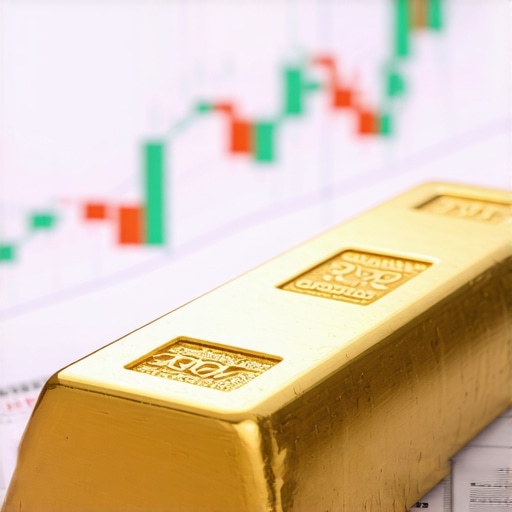Understanding the Importance of Diversification in Investment
In today’s ever-changing financial landscape, the concept of diversification has become more critical than ever. Investors are constantly looking for ways to protect their assets and maximize returns. One strategy that has gained significant traction is diversifying with gold. As we approach 2025, the reasons for incorporating gold into an investment portfolio are more compelling than ever.
The Resilience of Gold During Economic Uncertainty
Gold has long been regarded as a safe-haven asset. Its intrinsic value and universal acceptance make it a reliable choice during periods of economic uncertainty. Unlike stocks or bonds, gold is not directly affected by corporate performance or interest rates, which means it can provide stability when markets are volatile. This characteristic is particularly relevant as we navigate potential economic downturns predicted in the coming years.
Gold as a Hedge Against Inflation
Inflation erodes purchasing power, making it essential for investors to seek assets that can maintain their value. Gold has historically been a strong hedge against inflation. As central banks around the world continue to implement expansionary monetary policies, the value of fiat currencies may diminish, leading investors to flock to gold. Thus, including gold in your portfolio can safeguard against inflationary pressures and help maintain financial security.
Diversifying Your Portfolio with Gold
Incorporating gold into your investment strategy is not just about safety; it’s also about diversification. A well-diversified portfolio typically includes a mix of asset classes, and gold offers a unique opportunity to achieve this balance. By investing in gold, whether through physical gold, gold ETFs, or mining stocks, investors can reduce overall portfolio risk while enhancing potential returns. For a comprehensive approach to gold investments, consider reading our Ultimate Guide to Diversifying Your Portfolio with Gold.
Future Trends in Gold Investment
As we look ahead to 2025, the gold market is expected to evolve with changing demand trends. Factors such as global economic conditions, geopolitical tensions, and shifts in consumer behavior will play a significant role in influencing gold prices. Staying informed about these trends can help investors make strategic decisions. For insights on what to expect in the gold market, check out our article, Gold Demand Trends in 2025: What to Expect This Year.
Conclusion
In conclusion, diversifying with gold is a smart move for 2025. As a hedge against economic uncertainty and inflation, gold provides a stable foundation for an investment portfolio. By understanding the importance of diversification and keeping abreast of market trends, investors can make informed decisions that enhance their financial security in the years to come.
Why Gold Remains a Strategic Investment Choice
As we move closer to 2025, it’s essential to consider the strategic advantages of investing in gold. This precious metal has consistently proven its worth as a reliable component of a well-rounded investment strategy. Investors often question whether incorporating gold into their portfolios is worth it, especially in the face of emerging investment opportunities. However, the unique characteristics of gold make it a standout choice for anyone looking to secure their financial future.
Gold’s Role in Financial Security
In uncertain economic climates, gold serves as a bastion of stability. Its ability to retain value, even when other asset classes falter, makes it an essential part of any long-term investment plan. Many investors turn to gold as a protective measure against unpredictable market fluctuations. For those interested in understanding how gold can enhance their investment strategy, our article on how to diversify your portfolio with gold investments offers valuable insights.
The Demand for Gold in Emerging Markets
Emerging markets are playing a crucial role in shaping global gold demand. As economies in countries like India and China continue to grow, so does the appetite for gold, particularly for cultural and investment purposes. This increasing demand can significantly impact gold prices, making it an essential factor for investors to monitor. To stay updated on these trends, consider our post on gold demand trends in 2025.
Investing in Gold ETFs vs. Physical Gold
When deciding how to invest in gold, investors often weigh their options between physical gold and gold ETFs (Exchange-Traded Funds). Each has its own set of advantages and disadvantages. Investing in physical gold, such as coins or bars, provides tangible ownership but requires secure storage and insurance. On the other hand, gold ETFs offer liquidity and ease of trading, but investors don’t have physical possession of the gold. For a deeper dive into these investment options, our article on why invest in gold coins for financial security may be helpful.
Understanding Gold Mining Stocks
Gold mining stocks represent another avenue for investors seeking exposure to gold. These stocks can provide leveraged exposure to gold prices, as mining companies often benefit significantly from rising gold values. However, investing in mining stocks comes with its own risks, including operational challenges and fluctuating production costs. For those looking to explore this option, check out our comprehensive guide on gold mining stocks: risks and rewards.
Conclusion: A Bright Future for Gold Investments
As we approach 2025, the outlook for gold investments appears promising. With its historical performance, ability to hedge against inflation, and growing demand in emerging markets, gold remains a valuable asset. Investors who recognize the importance of integrating gold into their portfolios will likely reap the benefits of this timeless investment strategy. Stay informed about the gold market and consider how it can fit into your overall investment strategy to ensure financial security.
Evaluating Different Types of Gold Investments
As gold continues to shine as a secure investment, understanding the various forms in which it can be acquired is crucial for potential investors. Each type of gold investment offers unique advantages and challenges that can cater to different financial goals. This section will delve into the most popular methods of investing in gold, helping you make an informed choice.
Physical Gold: Coins and Bars
Investing in physical gold, such as coins and bars, remains one of the most traditional and popular methods. Many investors value the tangible nature of this form of investment because it provides a sense of security. Gold coins, like the American Gold Eagle or Canadian Maple Leaf, are widely recognized and can be easily traded. However, storing and insuring physical gold can pose challenges. Interested in learning more about this investment type? Check out our article on how to spot a reputable dealer for buying gold.
Gold ETFs: A Modern Alternative
Gold Exchange-Traded Funds (ETFs) offer a modern and convenient avenue for gold investment. These funds trade on stock exchanges, allowing investors to buy and sell shares easily, just like stocks. Gold ETFs typically track the price of gold, providing a way to invest without needing to physically hold the metal. For those looking to understand the pros and cons of gold ETFs, our post on are gold ETFs worth the investment in 2025 is a great resource.
Gold Mining Stocks: Risk and Reward
Investing in gold mining stocks can be a lucrative option for those willing to accept higher risk. These stocks represent shares in companies engaged in gold mining operations. When gold prices rise, mining stocks can experience significant gains; however, they are also subject to operational risks and market volatility. Investors interested in this route should consider our analysis of gold mining stocks: risks and rewards.
Gold Futures: Speculative Investment Strategies
Gold futures contracts provide a way for investors to speculate on the future price of gold. These contracts obligate the buyer to purchase gold at a predetermined price on a specified future date. While futures can offer substantial returns, they also come with significant risks and require a good understanding of market dynamics. For those new to futures, our article on understanding gold futures: a beginner’s approach can be particularly helpful.
Gold as an Inflation Hedge
One of the primary reasons investors flock to gold is its reputation as a hedge against inflation. As the value of currency decreases, the price of gold often rises, preserving purchasing power. This characteristic makes gold a strategic inclusion in any diversified investment portfolio. To explore how to effectively include gold in your financial strategy, refer to our guide on diversifying your portfolio with gold.
Conclusion: Tailoring Your Gold Investment Strategy
As you evaluate your options for investing in gold, consider your financial goals, risk tolerance, and investment timeline. Whether you opt for physical gold, ETFs, mining stocks, or futures, each choice presents distinct opportunities and challenges. By understanding the landscape of gold investments, you can position yourself to make well-informed decisions that align with your financial aspirations.
Understanding Gold Investment Risks and Rewards
Investing in gold entails navigating a landscape filled with both risks and rewards. As an investor, it is crucial to grasp the factors that can influence your investment outcomes. The volatility of gold prices can be attributed to various elements such as market demand, geopolitical events, and economic conditions. For a deeper understanding of current and future price fluctuations, check out our analysis on gold price forecasts for 2025.
Market Volatility and Price Fluctuations
Gold prices can experience significant volatility, influenced by global economic trends and investor sentiment. Understanding these market dynamics can help you make informed decisions. Investors should be aware that while gold is often considered a safe haven, it is not immune to price swings. A useful resource for understanding these trends is our article on analyzing gold price trends.
Global Economic Conditions
The performance of gold is intricately linked to global economic conditions. Factors such as inflation rates, interest rates, and currency stability play a critical role in influencing gold demand. During times of economic uncertainty, gold often sees increased interest as a secure asset. For insights on how economic shifts can impact your gold investments, refer to our guide on why gold remains a hedge against economic downturns.
Geopolitical Events and Their Impact on Gold Prices
Geopolitical events, including conflicts, trade disputes, and policy changes, can create fluctuations in gold prices. Investors should stay informed about global events that may affect gold demand. Understanding this connection allows investors to anticipate potential price movements. For a comprehensive overview of how global events shape gold demand, explore our post on the impact of global events on gold demand trends.
Long-Term vs. Short-Term Investment Strategies
When investing in gold, it is essential to distinguish between long-term and short-term strategies. Long-term investors may focus on the overall growth of gold prices, while short-term traders often capitalize on price fluctuations. Each approach has its benefits and challenges. For those new to gold trading, our article provides tips for traders.
Conclusion: Balancing Risks and Rewards
Investing in gold can be a rewarding venture if approached with a thorough understanding of the associated risks. By analyzing market trends, economic conditions, and geopolitical events, investors can develop a well-rounded strategy. Whether you are considering gold as a long-term asset or as a short-term trading opportunity, staying informed will enhance your investment decisions. To learn more about gold investment strategies, check our article on best gold investment strategies.
Frequently Asked Questions About Gold Investment
What are the advantages of investing in gold?
Investing in gold offers several advantages, including its role as a hedge against inflation, currency devaluation, and economic instability. Gold is also a tangible asset that can provide portfolio diversification and potential long-term appreciation in value.
Is gold a good investment in 2023?
As of 2023, many analysts believe gold remains a solid investment choice due to ongoing global uncertainties, inflation concerns, and central banks increasing their gold reserves. However, individual investment decisions should consider market conditions and personal financial goals.
How can beginners start investing in gold?
Beginners can start investing in gold by purchasing physical gold (like coins or bars), investing in gold exchange-traded funds (ETFs), or buying shares in gold mining companies. It’s essential to do thorough research and consider consulting with a financial advisor.
What factors affect gold prices?
Gold prices are influenced by various factors, including economic indicators, inflation rates, interest rates, geopolitical events, and changes in supply and demand. Monitoring these factors can help investors make informed decisions regarding their gold investments.
What is the difference between physical gold and gold ETFs?
Physical gold refers to tangible gold items such as coins and bars, while gold ETFs are investment funds that track the price of gold and can be traded on stock exchanges. Physical gold offers security and tangibility, while ETFs provide liquidity and ease of trading.
Can I lose money investing in gold?
Yes, like any investment, there is a risk of losing money when investing in gold. Price fluctuations can lead to temporary losses, especially for short-term investors. Thorough research and a well-thought-out strategy can help mitigate risks.
How does gold investment compare to other assets?
Gold is often viewed as a safe-haven asset compared to stocks and bonds. While stocks may offer higher returns in a booming economy, gold tends to retain value during economic downturns, making it a valuable diversification tool within an investment portfolio.
What are the tax implications of investing in gold?
Taxes on gold investments can vary by jurisdiction, but in many cases, profits from selling gold are subject to capital gains tax. It’s advisable to consult with a tax professional to understand the specific tax implications related to gold investments in your area.
How should I store my physical gold?
Physical gold should be stored securely in a safe or a safety deposit box at a bank. Proper storage is crucial to prevent theft or damage and to ensure the long-term value of the gold remains intact.
What is the historical performance of gold as an investment?
Historically, gold has been a reliable store of value, especially during periods of economic instability. While its price can be volatile in the short term, gold has shown long-term appreciation, making it a popular choice among investors seeking stability.
Authority Resources on Gold Investment
To further enhance your understanding of gold investment, consider exploring the following authoritative resources:
- World Gold Council – A comprehensive source for gold market information, including demand statistics and investment trends.
- Investopedia – Gold Investment Guide – An in-depth guide on various gold investment options, including pros and cons.
- Kitco – Offers live gold prices, market analysis, and news related to gold investments.
- BullionVault – A platform for buying and storing gold, with resources for understanding gold investing.
- Forbes – Investing in Gold – Articles and insights from experts on the benefits and risks of gold investment.
Conclusion: Embracing Gold Investment as a Financial Strategy
In conclusion, investing in gold represents a strategic approach to building wealth and securing financial stability. By understanding the risks, market dynamics, and investment strategies, you can navigate the world of gold investment effectively. Whether you’re a novice or an experienced investor, continuous learning and staying informed will empower you to make sound investment decisions. Gold can serve as a cornerstone of your investment portfolio, offering both security and potential for growth.











I’ve been gradually increasing my allocation to gold in the past couple of years, especially after seeing how it acts as a buffer during volatile markets. The article’s emphasis on gold’s resilience amid economic uncertainty rings true, especially considering how interconnected the global markets are these days. What really stood out to me is the dual role gold plays—not only as a safe haven during downturns but also as a hedge against inflation, which seems increasingly relevant with expansionary monetary policies in place worldwide.
One challenge I’ve faced is deciding between physical gold and ETFs. Physical gold feels more secure because you hold the asset directly, but storage and insurance can be tricky and expensive. Meanwhile, ETFs offer convenience and liquidity but lack that tangible aspect. The article’s suggestion to consider mining stocks as well is interesting; I hadn’t fully appreciated the leveraged exposure they offer, though I recognize the operational risks.
Given all these options, how do other investors strike the right balance between physical gold and paper gold investments? Also, has anyone explored gold futures? I’m curious about the risks and whether they balance out the potential rewards for a broader strategy. Any insights or experiences would be appreciated!
Morgan, I completely resonate with your observations about the challenge of balancing physical gold and ETFs in a portfolio. From my experience, physical gold offers a sense of security that’s psychologically comforting, especially during turbulent times. However, the practicalities of storage and insurance can sometimes outweigh this benefit for smaller investors. ETFs, on the other hand, provide flexibility and liquidity, which can be invaluable for adjusting positions in response to market changes quickly. Regarding gold futures, I’ve found them to be quite speculative and better suited for investors with a strong understanding of market timing and risk tolerance. Futures can amplify gains but also magnify losses, so they feel less appropriate for most long-term diversification strategies. What I appreciate about diversifying with gold, as this article highlights, is its ability to provide stability in the face of economic uncertainty and inflation without being tied to corporate or interest rate dynamics. For those trying to decide allocation, it might help to consider their investment horizon and risk appetite—perhaps using a core of physical gold or ETFs for stability and a smaller, more speculative slice in mining stocks or futures if comfortable. I’m curious, does anyone else incorporate a mix like this, or have shifted strategies based on recent economic signals heading into 2025?